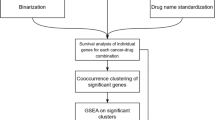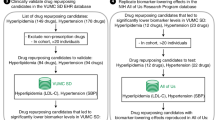Abstract
DNA microarrays are an integral part of the process for therapeutic discovery, optimization and clinical validation. At an early stage, investigators use arrays to prioritize a few genes as potential therapeutic targets on the basis of various criteria. Subsequently, gene expression analysis assists in drug discovery and toxicology by eliminating poor compounds and optimizing the selection of promising leads. Integral to this process is the use of sophisticated statistics, mathematics and bioinformatics to define statistically valid observations and to deduce complex patterns of phenotypes and biological pathways. In short, microarrays are redefining the drug discovery process by providing greater knowledge at each step and by illuminating the complex workings of biological systems.
This is a preview of subscription content, access via your institution
Access options
Subscribe to this journal
Receive 12 print issues and online access
$209.00 per year
only $17.42 per issue
Buy this article
- Purchase on Springer Link
- Instant access to full article PDF
Prices may be subject to local taxes which are calculated during checkout

Katie Ris


Katie Ris
Similar content being viewed by others
References
Golub, T.R. et al. Molecular classification of cancer: class discovery and class prediction by gene expression monitoring. Science 286, 531–537 (1999).
Pomeroy, S.L. et al. Prediction of central nervous system embryonal tumour outcome based on gene expression. Nature 415, 436–442 (2002).
Gordon, G.J. et al. Translation of microarray data into clinically relevant cancer diagnostic tests using gene expression ratios in lung cancer and mesothelioma. Cancer Res. 62, 4963–4967 (2002).
Petricoin, E.F. et al. Medical applications of microarray technologies: a regulatory science perspective. Nature Genet. 32, 474–479 (2002).
Fryer, R.M. et al. Global analysis of gene expression: methods, interpretation, and pitfalls. Exp. Nephrol. 10, 64–74 (2002).
Gerhold, D. & Caskey, C.T. It's the genes! EST access to human genome content. BioEssays 18, 973–981 (1996).
Tusher, V.G., Tibshirani, R. & Chu, G. Significance analysis of microarrays applied to the ionizing radiation response. Proc. Natl Acad. Sci. USA 98, 5116–5121 (2001).
Ideker, T., Thorsson, V., Siegel, A.F. & Hood, L.E. Testing for differentially-expressed genes by maximum-likelihood analysis of microarray data. J. Comput. Biol. 7, 805–817 (2000).
Hughes, T.R. et al. Functional discovery via a compendium of expression profiles. Cell 102, 109–126 (2000).
Efron, B. & Tibshirani, R. Empirical bayes methods and false discovery rates for microarrays. Genet. Epidemiol. 23, 70–86 (2002).
Xu, H. & Raafat el-Gewely, M. p53-responsive genes and the potential for cancer diagnostics and therapeutics development. Biotechnol. Annu. Rev. 7, 131–164 (2001).
Yang, Y.H. & Speed, T. Design issues for cDNA microarray experiments. Nature Rev. Genet. 3, 579–588 (2002).
Quackenbush, J. Computational analysis of microarray data. Nature Rev. Genet. 2, 418–427 (2001).
Eisen, M.B., Spellman, P.T., Brown, P.O. & Botstein, D. Cluster analysis and display of genome-wide expression patterns. Proc. Natl Acad. Sci. USA 95, 14863–14868 (1998).
Sarang, S.S. et al. Discovery of molecular mechanisms of neuroprotection using cell based bioassays and oligonucleotide arrays. Physiol. Genom. (2002); advance online publication 17 September 2002 (doi:10.1152/physiolgenomics. 00064.2002).
Butte, A.J., Tamayo, P., Slonim, D., Golub, T.R. & Kohane, I.S. Discovering functional relationships between RNA expression and chemotherapeutic susceptibility using relevance networks. Proc. Natl Acad. Sci. USA 97, 12182–12186 (2000).
Weinstein, J.N. et al. An information-intensive approach to the molecular pharmacology of cancer. Science 275, 343–349 (1997).
Staunton, J.E. et al. Chemosensitivity prediction by transcriptional profiling. Proc. Natl Acad. Sci. USA 98, 10787–10792 (2001).
Cho, Y.S. et al. Antisense DNAs as multisite genomic modulators identified by DNA microarray. Proc. Natl Acad. Sci. USA 98, 9819–9823 (2001).
Hannon, G.J. RNA interference. Nature 418, 244–251 (2002).
Fambrough, D., McClure, K., Kazlauskas, A. & Lander, E.S. Diverse signaling pathways activated by growth factor receptors induce broadly overlapping, rather than independent, sets of genes. Cell 97, 727–741 (1999).
Lee, S.B. et al. The Wilms tumor suppressor WT1 encodes a transcriptional activator of amphiregulin. Cell 98, 663–673 (1999).
Welcsh, P.L. et al. BRCA1 transcriptionally regulates genes involved in breast tumorigenesis. Proc. Natl Acad. Sci. USA 99, 7560–7565 (2002).
Staels, B. et al. Mechanism of action of fibrates on lipid and lipoprotein metabolism. Circulation 98, 2088–2093 (1998).
Hu, W.Y., Fukuda, N. & Kanmatsuse, K. Growth characteristics, angiotensin II generation, and microarray-determined gene expression in vascular smooth muscle cells from young spontaneously hypertensive rats. J. Hypertens. 20, 1323–1333 (2002).
Karpen, S.J. Nuclear receptor regulation of hepatic function. J. Hepatol. 36, 832–850 (2002).
Whitlock, J.P. Jr. & Denison, M.S. (ed.) Induction of Cytochrome P450 Enzymes that Metabolize Xenobiotics (Plenum, New York, 1995).
Gerhold, D. et al. Monitoring expression of genes involved in drug metabolism and toxicology using DNA microarrays. Physiol. Genom. 5, 161–170 (2001).
Rodrigues, A.D. & Rushmore, T.H. Cytochrome P450 pharmacogenetics in drug development: in vitro studies and clinical consequences. Curr. Drug Metab. 3, 289–309 (2002).
Hansten, P.D. & Horn, J.R. The Top 100 Drug Interactions: A Guide to Patient Management (H&H Publications, Edmonds, WA, 2002).
Heimark, L.D., Gibaldi, M., Trager, W.F., O'Reilly, R.A. & Goulart, D.A. The mechanism of the warfarin–rifampin drug interaction in humans. Clin. Pharmacol. Ther. 42, 388–394 (1987).
Baker, T.K. et al. Temporal gene expression analysis of monolayer cultured rat hepatocytes. Chem. Res. Toxicol. 14, 1218–1231 (2001).
Waring, J.F. et al. Clustering of hepatotoxins based on mechanism of toxicity using gene expression profiles. Toxicol. Appl. Pharmacol. 175, 28–42 (2001).
Scherf, U. et al. A gene expression database for the molecular pharmacology of cancer. Nature Genet. 24, 236–244 (2000).
Hamadeh, H.K. et al. Prediction of compound signature using high density gene expression profiling. Toxicol. Sci. 67, 232–240 (2002).
Thomas, R.S. et al. Identification of toxicologically predictive gene sets using cDNA microarrays. Mol. Pharmacol. 60, 1189–1194 (2001).
Burczynski, M.E. et al. Toxicogenomics-based discrimination of toxic mechanism in HepG2 human hepatoma cells. Toxicol. Sci. 58, 399–415 (2000).
Pennie, W.D., Woodyatt, N.J., Aldridge, T.C. & Orphanides, G. Application of genomics to the definition of the molecular basis for toxicity. Toxicol. Lett. 120, 353–358 (2001).
Ueda, A. et al. Diverse roles of the nuclear orphan receptor CAR in regulating hepatic genes in response to phenobarbital. Mol. Pharmacol. 61, 1–6 (2002).
Wei, P., Zhang, J., Dowhan, D.H., Han, Y. & Moore, D.D. Specific and overlapping functions of the nuclear hormone receptors CAR and PXR in xenobiotic response. Pharmacogenom. J. 2, 117–126 (2002).
Acknowledgements
We thank the many people who have assisted us in understanding the power and utility of using microarrays. The work is supported by the National Institute of Diabetes & Digestive & Kidney Diseases Biotechnology Center Consortium (S.R.G. and R.V.J.). S.R.G. is currently on a leave of absence at US Genomics.
Author information
Authors and Affiliations
Corresponding author
Ethics declarations
Competing interests
The authors declare no competing financial interests.
Rights and permissions
About this article
Cite this article
Gerhold, D., Jensen, R. & Gullans, S. Better therapeutics through microarrays. Nat Genet 32 (Suppl 4), 547–552 (2002). https://doi.org/10.1038/ng1042
Issue Date:
DOI: https://doi.org/10.1038/ng1042
This article is cited by
-
Combined Transcriptomics and Chemical-Genetics Reveal Molecular Mode of Action of Valproic acid, an Anticancer Molecule using Budding Yeast Model
Scientific Reports (2016)
-
Improvement of experimental testing and network training conditions with genome-wide microarrays for more accurate predictions of drug gene targets
BMC Systems Biology (2014)
-
RETRACTED ARTICLE: Intragastric exposure to titanium dioxide nanoparticles induced nephrotoxicity in mice, assessed by physiological and gene expression modifications
Particle and Fibre Toxicology (2013)
-
Analysis of the Gene Expression Profile of Curcumin-Treated Kidney on Endotoxin-Induced Renal Inflammation
Inflammation (2013)
-
Dexamethasone Stimulated Gene Expression in Peripheral Blood is a Sensitive Marker for Glucocorticoid Receptor Resistance in Depressed Patients
Neuropsychopharmacology (2012)



